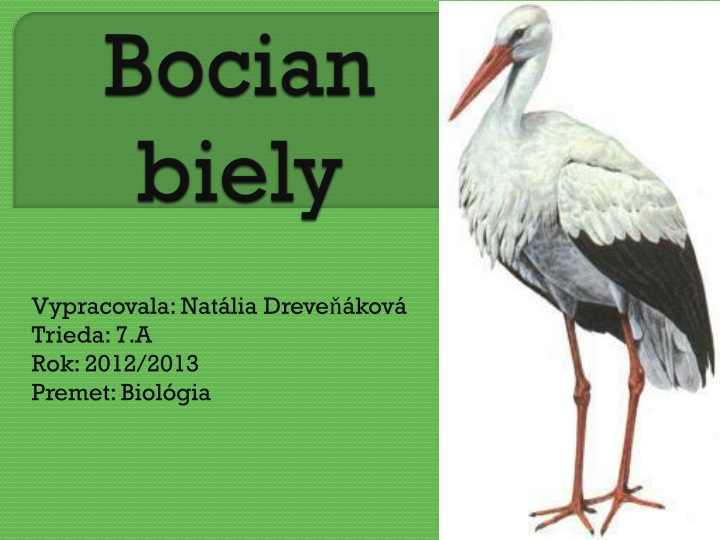
Fascinating Facts about the White Stork - A Closer Look
Delve into the world of the White Stork (Ciconia ciconia) with this informative content covering its physical characteristics, behaviors, habitat preferences, and migratory patterns. Explore how these majestic birds build their nests, hunt for food, and maneuver gracefully both on land and in the air. Discover intriguing details about their nesting habits, breeding cycle, and unique features that make them stand out in the avian world.
Uploaded on | 1 Views
Download Presentation

Please find below an Image/Link to download the presentation.
The content on the website is provided AS IS for your information and personal use only. It may not be sold, licensed, or shared on other websites without obtaining consent from the author. If you encounter any issues during the download, it is possible that the publisher has removed the file from their server.
You are allowed to download the files provided on this website for personal or commercial use, subject to the condition that they are used lawfully. All files are the property of their respective owners.
The content on the website is provided AS IS for your information and personal use only. It may not be sold, licensed, or shared on other websites without obtaining consent from the author.
E N D
Presentation Transcript
Vypracovala: Natlia Drevekov Trieda: 7.A Rok: 2012/2013 Premet: Biol gia
Latinsk nzov: Ciconia ciconia. Slovensk n zov: Bocian biely Patr do e ade bocianovit . Jeho hmotnos sa pohybuje v rozmedz 2,3 4,4 kg. dosahuje v ku 95 105 cm a rozp tie kr del je 155 165 cm. Farba preva uje biela farba, konce letiek s ierne, zob k a dlh nohy s erven , u ml at tmav . M pri lete natiahnut krk. Typick m zvukov m prejavom je klopanie zob kom. iv sa abami, rybami, hadmi, hmyzom a mal mi cicavcami.
Vyhba sa lesom. Vy aduje vlhk , na vodu bohat l ky so skupinkami stromov. Vyh ba sa aj trstin m. S ahovav vt k. Hniezdi na hrebe och striech, kom noch a st poch.
Na zimu sa sahuje do vchodnej a junej Afriky. Prilieta za iatkom apr la, kedy sa za na obdobie hniezdenia.
Hniezdo z vetiev a konrov si stavia na stromoch, strech ch, kom noch. Hniezdenie prebieha bu jednotlivo, alebo v men ch skupin ch za na v apr li alebo m ji. Samica zn a v inou 2 a 5 vajec. Ich inkub cia trv pribli ne 33 dn , po as ktor ch sa rodi ia pri zahrievan striedaj . Dva mesiace po vyliahnut sa ml at u ia lieta .
Po zemi sa pohybuje pomalou, akoby rozvnou ch dzou. Pri prenasledovan koristi vie aj uteka . Po as odpo inku za polud aj ch hor av i v noci bocian stoj na jednej nohe, hlavu si stiahnu medzi lopatky a zob k ukr vaj do peria na hrudi. Pred tartom na rovine urob bocian v dy nieko ko rozbehov ch krokov. tartuje proti vetru. Nohy smeruj dozadu a s mierne spusten . Po as akt vneho letu je z ber kr dlami pomal , rovnomern a siln .
www.sk.wikipedia.org www.snaturou2000.sk
